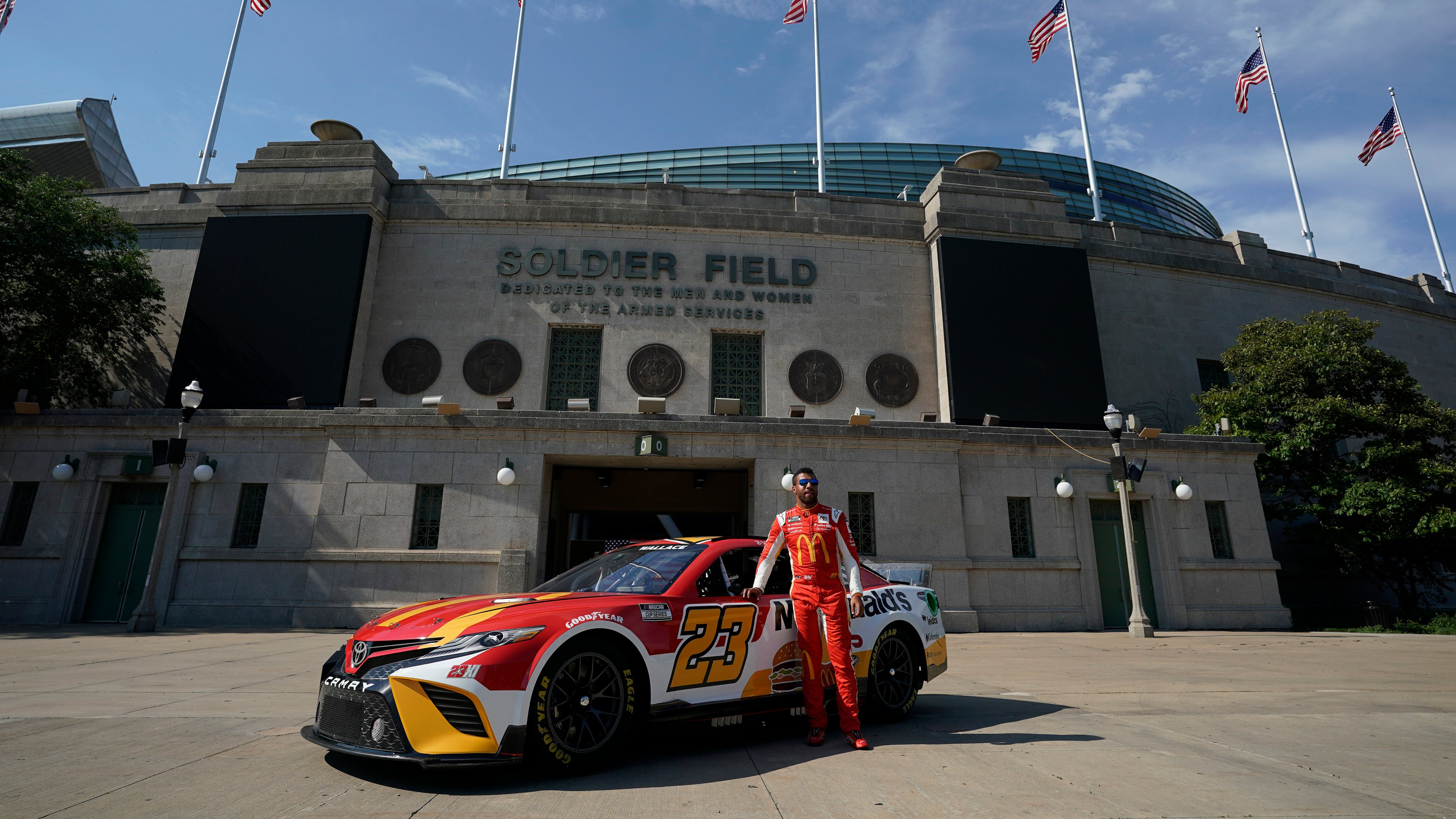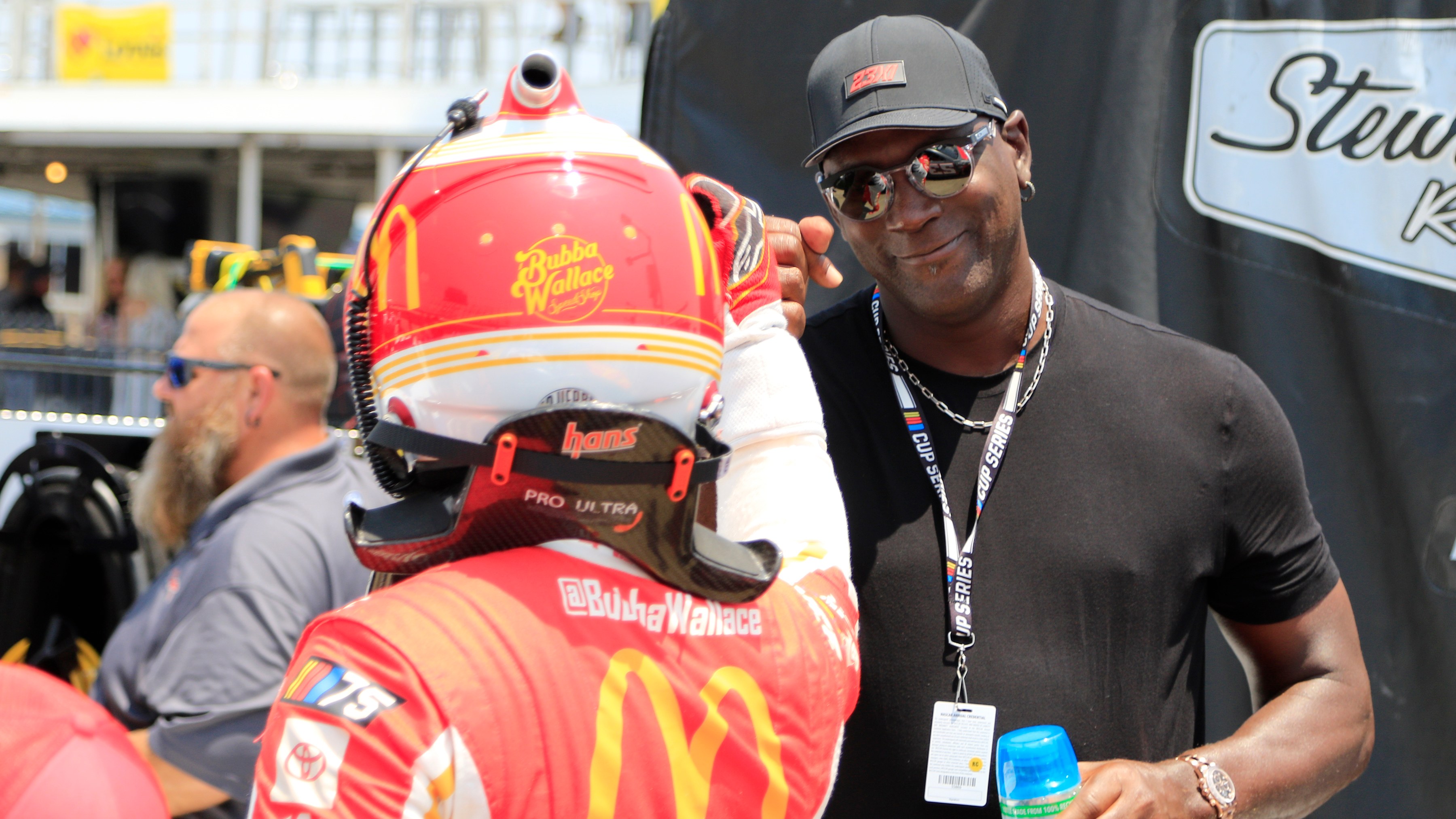Everyone understands the goal in NASCAR – drive fast and finish first.
But there’s more to the sport than outrunning the competition.
With the circuit coming to Chicago for the first-ever street race, it’s a good time to familiarize yourself with some niche NASCAR terms. If you hear things like “marbles” and “lucky dog,” they might have a different meaning than you think.
Here’s a full guide to some NASCAR terms and phrases that new viewers should know:
Flags: Each track has a flagstand at the start-finish line, where the flagman waves different colored flags as a signal to the drivers on the track. Here’s what the different colors indicate:
- Green: When the race is under green flag, it means the track is clear of any accidents and the cars are free to drive at full race speed.
- Yellow: The yellow flag, also known as the caution flag, means there has been an incident on track that requires cars to slow down. The pace car comes onto the track when the yellow flag is waved and all the drivers follow behind at a reduced caution speed. Cautions are thrown if there is a crash or unsafe debris on the track. Drivers cannot pass each other on the track under caution, but they can gain or lose spots if they stop for tires or fuel.
- Red: All cars are required to stop when the red flag is waved. This flag is used when there is a significant accident on the track, potentially blocking cars from continuing on. Red flags are also used during weather delays.
- Black: A black flag is shown to a driver when they have an unserved penalty or car malfunction that requires pitting. Drivers are forced to stop and serve their penalty or address the car problem immediately when they receive a black flag.
- White: The white flag is waved as cars begin their final lap of the race. Broadcasters will frequently say the leader “takes” the white flag or “sees” the white flag when they cross the line with one lap to go.
- Checkered: When you see the checkered flag, that means the race is over. Cars cross the start-finish line for the final time as the checkered flag waves.
Penalties: Drivers can receive penalties during races, with punishments of varying degrees. Here are some of the consequences for receiving a penalty:
- Stop and go: This requires a driver to drive down pit road and come to a complete stop in their pit stall before returning to the race.
- Pass through: This requires a driver to drive through pit road, without any stops, before rejoining the race.
- Tail end of the long line: If a driver receives a penalty during a caution flag, they are required to restart the race at the back of the pack. Drivers must drop to the rear, regardless of where they were running before the penalty.
Pit stops and crews: Drivers make pit stops throughout each race, where they drive down pit road and stop in their pit box as their pit crew can change tires, add fuel and adjust the car setup.
Feeling out of the loop? We'll catch you up on the Chicago news you need to know. Sign up for the weekly Chicago Catch-Up newsletter.
- Crew chief: If you think of drivers like players in traditional sports, crew chiefs are equivalent to a head coach. They are stationed on pit road, frequently communicating with their driver over the radio for strategies and adjustments. They are responsible for setting up the car, making adjustments and deciding strategy.
- Spotter: During oval races, drivers have one spotter who stands in the “spotter stand” at the highest point of the track. They are on the radio channel with the driver and crew chief, but their role is strictly to tell the driver what’s happening around them and, hopefully, keep them out of trouble. At road and street courses, drivers have multiple spotters stationed throughout the track because they are longer in distance and impossible for one person to see the whole thing.
- Short pit: Teams will often wait until the car runs out of fuel or the tires are used up before hitting pit road. In some instances, though, they will “short pit” – opting to come down pit road earlier than expected, with the hope of gaining time on their competition due to having fresh tires.
- Stickers: Fresh, unused tires are called “stickers.”
- Scuffs: If a team runs out of stickers, sometimes they have to put on old, used tires. These tires are called “scuffs.”
Adjustments, handling, car parts, tracks
- Chassis: This is the part of the car that includes the floorboard, interior and roll cage.
- Handling: Drivers will report back to their crews with information about how their car is “handling.” “Not handling well,” “ill-handling” and “liking the handling” are some ways that drivers could describe how their car feels to them.
- Loose: When a car is described as “loose,” it means the back tires are hard to control when entering or exiting a turn due to a lack of grip. This causes the car to “fishtail,” where the rear is sliding.
- Tight: On the other side, “tight” means that the front tires are tougher to control in the corners. The equivalent feeling in a street car would be like using front-wheel-drive during icy conditions.
- Spoiler: The long strip of medal attached to the rear of the car is called a spoiler. Many street cars have spoilers, but they are more crucial in racing as they reduce drag and provide downforce.
- Splitter: Located at the front of the car nearly touching the ground, the splitter provides downforce like the spoiler. Any damage to the splitter, whether from hitting the wall or sliding in the grass, can be terminal to the car.
- SAFER barrier: The Steel and Foam Energy Reduction barrier system (SAFER), for lack of a better explanation, makes hitting the wall… safer. It’s an impact-absorbing wall attachment that softens the blow when cars crash into it. This system grew in the years after Dale Earnhardt’s death in 2001 and is now used on most walls at standard tracks.
- HANS device: Another safety measure added after Earnhardt’s death, the HANS device is a neck restraint that is mandatory to wear while driving. It essentially rests on the back of a drivers’ neck and is strapped into place in an effort to keep their heads stable and avoid potential whiplash during accidents or sharp stops.
- Dirty air vs. clean air: During a NASCAR race, you’ll hear a lot about dirty and clean air. Basically, cars handle better when they are in clean air – when there’s no traffic in front. Dirty air is when a car is stuck behind other vehicles, which causes turbulence and can either tighten or loosen up a car and upset the handling.
- Preferred lane/groove: Especially at a street course like Chicago, drivers will be fighting to get into the preferred lane. Staying on the optimal racing line is critical for driving faster and passing others.
- Marbles: No, there aren’t actual marbles on race tracks. When a driver is out of the preferred lane, announcers will often say they are “in the marbles.” Marbles, in this case, are small bits of rubber that come off tires and accumulate in areas of the track where cars don’t frequently drive. Driving through the marbles can sometimes cause a driver to lose control of the car, or at the very least slow them down.
Race procedure
- Pole: The driver who has the quickest lap in qualifying starts “on the pole,” meaning he or she lines up in first place to begin the race.
- Restart: At the end of each caution, there is a restart. Drivers line up two-by-two and accelerate to race speed in the restart zone as the green flag waves.
- Choose rule: On the lap before each restart, the choose rule comes into effect. This is a line painted on the track, where drivers must choose which of the two lanes they want to restart from – left or right. Depending on the track, the preferred lane can change. Sometimes, drivers will take the non-preferred lane if it advances them further in the restart order.
- Green-white-checkered: This term is used when there is a restart with two laps to go in a race. At the restart, the green flag is waved. Once the cars make a lap, the white flag is waved. And when they come to the line again, the checkered flag flies.
- Overtime: If there is a caution late in a race, it can go into overtime. Overtime is used when the race goes past its scheduled distance due to a caution. Overtime restarts are green-white-checkered finishes and they can have unlimited attempts.
- Lap down: Cars at the back of the field that are passed by the leader are considered “lapped.” They are a lap down, meaning they have completed one fewer lap than the leader.
- Free pass/lucky dog: During each caution, the first lapped car gets the “free pass” to get back on the lead lap. Sometimes called the “lucky dog,” this one driver gets a free lap around the track to catch back up to the field under caution and restarts at the rear.
- Wave around: If a driver is a lap down but isn’t in position for the free pass, they can sometimes get their lap back using the wave around. This option becomes available to lapped cars if the leaders pit under caution, allowing the wave around cars to circle the track and get a lap back just like the free pass car. The only difference is that wave around cars are unable to pit under caution, which can put them at a disadvantage for fuel and tires.
- Back marker: Drivers racing at the back of the pack are sometimes referred to as “back markers.”
- Race control/tower: These words are used to identify NASCAR officials. Just like the NBA or NFL, there is a group away from the playing field or race track that can call penalties.
On-track incidents
- Bump and run: This is when a driver bumps another from behind, out of the preferred lane and drives past for the position.
- Blow up: No, the car is not literally blowing up when announcers say this. It just means the car’s engine has expired and is unfixable.
- Cut a tire: Also referred to as “blowing a tire,” this is when a tire has a puncture and has to be changed.
- Kiss the wall: This one isn’t as cute as it sounds. Sometimes, drivers will get close to the wall and just barely make contact. That’s known as “kissing the wall,” as the damage is not severe but there was a connection.



